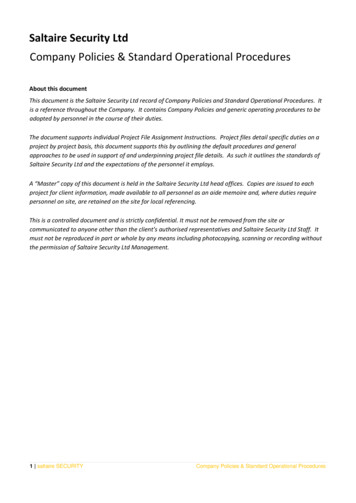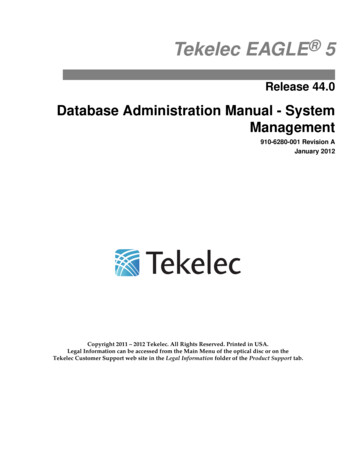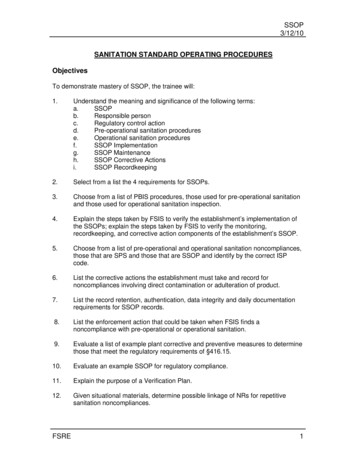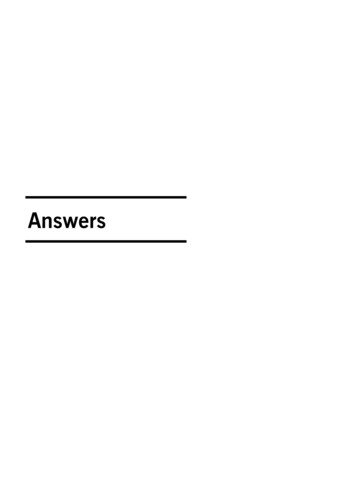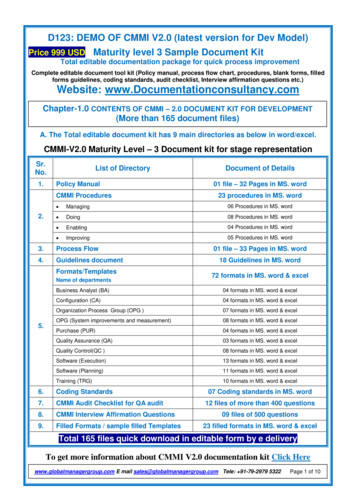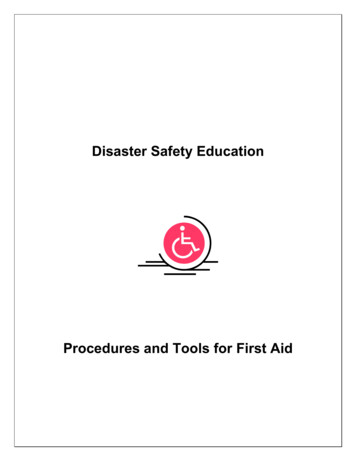
Transcription
Disaster Safety EducationProcedures and Tools for First Aid
Procedures and Tools for First AidBackgroundDuring a disaster, there will definitely be victims, because an event is still notconsidered disaster if there are no victims, such as deaths, damage to property, socialstructure, infrastructure or environmental damage. Sometimes the number of victims isnot the direct result of the disaster but victims can still fall because of inappropriate firstaid. Therefore, we should improve our understanding regarding the principles andprocedures as well as skills in dealing with disaster victims.Immediately after a sudden or forewarned disaster, while panic and total confusion stillrules, we should keep calm and thoughtful in coping. The steps we take to help victimswill very much affect their future condition. First aid administered accurately and quicklywill be very important for the victim’s survival.1. Objectives of first aidThe main objectives of first aid are as follows:Prevent the worsening of the conditions of victimsMany fatalities happen because victims received help too late or because of ignoranceof people at the scene in administering first aid, e.g., if a victim suffers a wound that isbleeding a little, try as quickly as possible to stop the bleeding in order to prevent aserious blood shortage. Use a sterile bandage otherwsie an infection may furtherworsen the victim’s condition.Prevent additional victimsDuring a disaster situation there can be a large number of victims. The purpose of firstaid is to prevent this number from growing and the victims’ conditions from worsening,e.g., when helping someone is drowning in a river, the helper should be able to swimand understand the condition of the river current. This is to prevent the helper from alsodrowning and increasing casualties.Facilitate further handlingFirst aid is only a temporary measure and therefore will still need further aid fromcompetent officials and agencies such as midwives, medical aides, doctors, andhospitals. Therefore when administering first aid, refrain from methods that couldcomplicate further aid treatments, e.g., do not put strange ointments on the woundbecause it will have to be cleaned once the person get, and this would definitely takesvaluable time.2
Mitigate the victim’s sufferingBy administering first aid, hopefully physical suffering such as pain and panic can beminimized. Give encouragement, e.g., help will be coming soon; the wound is not soserious; wrap a burn with young banana leaves.Components of first aidVictimThe main aid component is victim as the person who needs helpHelperA helper is someone whose condition is better than the victim’s, with willingness andability to apply first aid.Sickness/injurySickness/injury is a condition which makes a victim suffer, it may include physical orpsychological sickness. What should be known regarding sickness/injury is theinjury/sickness type, treatment principles, and methods of administering first aid.Priority attentionDuring an emergency situation the total number of victims is usually higher than thenumber of helpers, so helpers should establish the priority of the victims to help first. Select victims most able to be helpedGive precedence to victims needing minor treatment so they can assist others.Give more attention to patients with a high level of fear and panic in order to preventa disruption of the aid processWhenever there are victims in a buried position/covered by something and must belocated, those found first should be helped immediately.Whenever a deceased victim is found, wait and focus on finding other safe victims.Get victims who can participate actively involved in searching for help.When a victim is found with multiple injuries/sickness, apply help in this order1. Breathing disorder2. Bleeding3. Loss of consciousness4. Bone fractures3
How to deal with injuriesCompetence:Participants will be able to understand the principles and procedures, as well as how touse the tools suitable for administering first aid.Quality Input: First Aid Kit,Alternative First Aid equipment,Rehearsal equipmentActivities for first aid1. Bleeding woundsDuring certain disasters, a bleeding wound may occur, e.g., piercing by flying buildingmaterial during a cyclone, being struck down by building debris, scratching by a sharpobject. Keep in mind that a bleeding wound can be quite dangerous and shouldstraightaway be treated because of several factors: Whenever there is a loss of blood exceeding 20% of the total blood in a humanbody, this may cause unconsciousness and when no immediate help is given couldresult in death.Blood outflow from a wound. A wound represents a window for viruses or bacteria toenter the body, therefore the wound should be covered immediately to prevent aninfection.Internal bleedingInternal bleeding occurs when there is an internal body wound, although no blood hasleft the body. Body parts that often experience internal bleeding are the thoracic cavity,the stomach cavity and the head cavity.Applying aid is through calming the victim, and by taking him/her a clinic or hospital asquickly as possible, because the treatment is limited to those with special competence.Internal bleeding symptoms: Stomach cavity bleeding is indicated by enlarged, hard and stiff stomachThoracic cavity bleeding is indicated by short-windedness.Head cavity bleeding by decreasing consciousness and may result in paralysis.4
External bleedingExternal bleeding occurs when skin is scratched and blood seeps out of the bodythrough the wound/scratch.External bleeding symptoms: Scratches and wounds on skinBleeding of woundPainDizziness caused by too much blood loss5
Although the body has the ability to stop bleeding, it is necessary to apply first aidagainst a bleeding wound. The main way to do this is through: exerting pressure on the woundplacing a bandage on the woundexerting pressure and placing a bandage (tourniquet) on the woundexerting pressure on internal blood center points, for instance by the neck side,underneath the upper armand even when there is no more bleeding, the wound should still be covered toprevent bacteria/germs from entering through the open skin.2. Treatment of woundsA wound is usually treated by bandaging.Locate wound positionWounds in different locations demand different treatment, therefore it is most importantwhen a victim is still conscious not to move a lot and to remain in a seating or standingposition (position of head should be the highest).Pay attention to the human body’s anatomical shapeDuring the treatment of a wound, the body’s anatomy has to be noticed, because it willaffect the bandaging method. It comprises three basic shapes: cylindrical, e.g., arm, thigh, calf, neck, body.round, e.g., head.joint, e.g., elbow, heel, and knee.Identify size of the wound (extent and intensity of blood outflow)The size of a wound determines the treatment method, even though it follows the sameprinciples. Cover wound and stop the bleeding. There are four methods to stopbleeding: applying pressure, bandaging, bandaging and applying pressure (tourniquet)and total bandaging.When trying to stop bleeding, do not bind too loose as blood will not stop but also do notbind too tight, as this will stop blood from flowing to the wounded area. Therefore it isnecessary to ask a victim, whether the bandage is too loose or too tight. When noresponse can be obtained from the victim, the bandage tightness is done in such a waythat the pulse can still be felt beneath the bandage.6
3. BurnsA burn may occur because of fire from an electrical short-circuit, a stove or machinery.Intensity level of a burnThe intensity level is established in 2 ways, i.e., percentage of the burned body part andthe degree of extent and depth of burned skin.PercentageBased on burned body parts, the percentages of burned bodysurface can be observed in picture 1 as follows: Head until neck 9%,Left or right arm 9%,Front body part (stomach and chest) 18%,Back body part (back) 18%,Upper left leg 9%,Upper right leg 9%,Lower right leg 9%,Lower left leg 9%,Genitals 1%,Total: 100Picture 1: Percentage of burned body surfaceDegreeThe degree refers to the depth level of burn suffered by a victim. Four degrees of burndepth exist, and the symptoms are as presented in the following table.Table 1: Degrees of a burn and the symptomsDegree1Indications/SymptomsReddish skin but painful when touched. The burned part of skinis only down to the epidermis2Skin blisters and peels off, and is painful when touched.3Skin peels off until colored white mingled with blue, not painfuleven if pierced with a needle, because the burn has alreadydamaged the nervous system network existing in the skin.4Skin and flesh are already burned. Bone is seen. Victim doesnot feel anything around burned area. Feels intense heat/thirst.7
Burn symptomsThe presence of a burn can be observed from the combination of symptoms as follows: Red colored skin Blistered skin Peeling off skin Painful when touched Feeling very hot Flesh get burned until the bones can be seen Stinging smell Feeling very thirsty Not bleedingPrinciples of first aid against burns Stop deepening process of the burn. Most effective: pouring or soaking the woundwith cold and clean water. When a burn causes skin to peel off, immediately cover the wound with a cleancloth, avoid smearing with anything else to prevent risk of infection that maycomplicate further treatment. Cover the wound using a sterile cloth, for instance analready washed and ironed clean handkerchief or clean plastic. After the wound is covered, a bandage may be applied. Bandaging a burn isdifferent than bandaging a bleeding wound. During bandaging a burn, it is importantto be sure that the wound is covered rather than the tightness of the bandage. After the wound is covered, try to get further treatment.8
4. Broken boneA broken bone wound refers to a wound which occurs on a bone, in the form ofcracking, breaking or sticking out of the body. Broken bones are injuries most commonduring earthquakes. The cause of a broken bone is for instance being struck by buildingdebris, trampled on, getting squeezed.Types of broken bone wounds Fractured bone: a bone experiences trauma/impact it may cause the bone to crack,but not break apart. Closed broken bone: a bone breaks, but is still inside the body. Open broken bone: a bone breaks and sticks out through the skin.Symptoms of broken bone woundsSeveral symptoms easily recognizable are among others: Black and blueSwollenVery painful when touched or movedChange in formBroken neck bone can be noticed when there are wounds on both head and neckBroken backbone can be noticed when there is a difference in the length of the legsBroken rib-bone is followed by breathing difficultiesPrinciples of first aid against broken bone woundsThe first aid principle to address a broken bone wound is through the fixation torest/minimize activity of the two joints that flank the broken bone. This is necessary toprevent friction of the broken bone. Friction of a broken bone can aggravate the wound.Treatment of broken bone woundsTreatment of a broken bone wound (fixation) is known as splint bandaging. Fixation isdone by applying two splints comprising of wood lined with thin cloth/sponge. Thesplints, each two centimeter in length are meant to flank the fracture location, which arethen bound with a rope, and tightened to support the broken body part and prevent itfrom suspending.Treating a broken neck is by propping up the neck to prevent any movement, whetherleft and right, to and fro, as well as turning around.A broken back does not need first aid, but needs special aid from competent persons.What should be exercised is to make victim remain in a lying down position, and tomake use of a flat and hard palanquin when transferring the victim to a differentlocation.9
When treating a victim with a broken collarbone, no splints are needed, only a shoulderbinder to retain its position and prevent the victim from stooping.In the case of an open broken bone, first step is to cover the wound, and thereafterconduct a fixation against the broken bone.Keep in mind:In treating broken bone wounds, do not try to restore the bone to its original position, bypressing, pulling or reinserting the stuck out bone.If no splints are available, part of the victim’s body can be utilized as a splint. Forinstance in the case of a broken lower arm, fixation can be done by binding the brokenarm to the victim’s body.Picture 2. Treatment of a victim with a broken arm10
5. Evacuation techniques for persons with injuriesDefinition of evacuationEvacuation is defined as transferring a victim from one place to another with the hope ofreceiving further aid, in order of his/her condition not aggravated or to prevent hazardsfrom other threats for instance aftershocks, landslides or fires.Objectives of evacuationThe objectives of an evacuation are to protect victims from the surrounding conditionsagainst possible aftershocks, and to receive further aid when deemed necessary.Evacuation requirementsAn important requirement for evacuation is the stable condition of the victim, forinstance breathing is normal again; bleeding has stopped; victim is conscious again.The above mentioned requirements may be ignored if the area where the victim iscurrently located is still unsafe from hazards, for instance fire hazards.Evacuation methodTo evacuate in a simple manner is to transfer a victim by carrying, with or withoutsupport tools. The transferring of a victim may be well exercised by 2 to 6 persons. In aspecific situation, evacuation may be carried out alone, for instance from inside a verynarrow collapsed building. Keep in mind that the evacuator should rely on his ability totransfer a victim. If he/she is apparently unable, he/she should seek help.Evacuation equipmentEvacuation equipments are tools that can be used for transferring a victim to a saferplace. The use of evacuation equipments should be adapted to the total number ofhelpers and to the injury/sickness condition of the victimFor transport we know two tools usually used i.e. a long board and a dragbar, bothfunctioning as palanquins. Other than these two standard tools, there are also simpletools by utilizing surrounding objects such as a door, ladder, sofa, chair, blanket,stocking or a rice/fertilizer bag.Recognizing support tools to provide aidSupport tools for administering aid are used if the patient’s condition needsadministering aid with support tools, because there are many cases where a patientdoes not need a support tool, e.g. getting knocked or bruised, ignited by fire, gettingslightly scratched and bleeding has already stopped by itself, etc. However, there a lotof cases where the use of support tools is required to help disaster victims exist.11
In this module standard support tools are introduced, i.e. support tools in line withmedical standards for helping disaster victims. These tools can be purchased, or selfmade, but most important is that these tools are capable of providing ease to patientsand helpers in coping with disaster cases.Recognizing surrounding objects that can be used for administering aidDuring a disaster situation, although the preparation is already thought adequate, quiteoften the tools already prepared prove to be insufficient or inappropriate. This conditiondemands the ability to use surrounding objects as replacements for standard tools fortreating victims. Although very different when compared to standard equipment, thesereplacement tools can be utilized to administer aid. Samples of replacement toolsinclude:Table 2 Alternative support tool samples to administer aidNoStandard tool/material1PalanquinReplacement objectsLadder, blanket, chair, bag, stocking2SplintsBanana branch, wood, bamboo, cardboard box3Dressing clothHandkerchief, clean cloth4Burn wound coverYoung banana leaf, sterile cloth, sterile plastic5MaskStocking, towel, sarong6Triangle clothMidrib of banana leaf, raffia rope, a torn piece ofcloth, belt, shoelace7MedicinesSeveral types of medicine plants around us, forinstance banana tree sap, vanilla leaf sap,papaya leaves, lamtoro leaves, balsam.12
STUDENT ACTIVITY SHEET 1TOPIC: Treatment of bleeding woundsObjective:Participants will be able to simulate the treatment and bandaging techniques ofbleeding wounds.Tools and Materials: Bandage or triangle cloth to apply pressure and bind.Pictures of various aid stagesActivitiesThe principle of treating bleeding wounds is to as quickly as possible stop blood outflow,because it can be fatal if blood outflow exceeds 20% of the total blood in the body.The next principle is to as quickly as possible cover the wound, because open skinpresents an entrance for bacteria and other germs to the body. A sterile cloth should beused when applying a bandage to prevent the wound from catching an infection, or oneshould apply disinfectant to the wound if available.Another important point is that the bandage applied to a wound should not be too tight,because this might obstruct other body parts, or too loose, because otherwise thebleeding will not stop. If the victim is conscious please ask him/her about the bandagetightness, but if the victim is unconscious one should check for pulse signs around thewound area.Activity 1: Bleeding wound treatment on cylindrical body parts1. Clean the wound with disinfectant ormedicine of the same sort.2. Prepare a triangle cloth (bandage).3. Cover the wound with the bandage, tie itwith a slipknot.4. If the wound is large, apply a sterilepressing tool on wound, or use a pressingtool in the shape of a cardboard box or apiece of wood if the wound is large andbleeding rapidly.13
5. After applying a pressing tool, bind the wound straightaway using the next method.Activity 2: Bleeding wound treatment on round body parts1. Determine if the wound needs a pressing tool or not, if considered necessary applya pressing tool.2. Prepare an already folded bandage.3. Start binding starting from the wound area.4. Bind around the head in circles, upon arriving oppositeof the wounded area, cross the bandage.5. After crossing, tie bandage in shape of a parcel(not in the direction of first binding) until arrivingat the position of the wound. When reaching thesame position as the wound, tie with a slipknot.14
6. If a wound exists on the chin or upper forehead, a triangular cloth is needed toprevent the bandage from coming loose.7. After the wound is pressed, tie a pair of stringsfrom bottom to behind the head, going abovethe ears. Then tie with a slipknot.8. Tie another pair of strings to the direction of behind thehead via below the ears. Make sure binding is not tooloose and not too tight.Activity 3: Bleeding wound treatment on the joint area1. For instance a wound exists on the knee.2. Prepare pressing tool and a tying bandage which isalready tied-up.15
3. Bandage the wound starting from the wound area; pullboth ends of the bandage to behind the knee, crossthem.4. After crossing, pull both tying strings up front to belowthe knee, cross them again.5. After having crossed, pull the tying strings to behind theknee, and after crossing pull tying strings again up frontof the knee in the direction of above the knee. Check thetightness of the tying strings.16
STUDENT ACTIVITY SHEET 2TOPIC: Treatment of BurnsOBJECTIVE:Participants will be able to simulate burn treatment techniques.TOOLS AND MATERIAL Triangular clothPictures of various aid stagesACTIVITY STEPSThe first process of administering aid to a burn victim is to prevent the burn fromdeepening, by pouring cold fluid onto the wound, i.e. clean water or antibiotic medicine.This is necessary because in general, a burn tends to undergo a deepening process ifno appropriate measures are taken.Avoid adding any substances to the wound because it may complicate furthertreatment. After having carried out the measure as good as possible, cover the woundstraight away. This is necessary to prevent germs or dirt from entering through the openskin. It is suggested that before covering with cloth, one should first cover the woundwith a sterile substance, cold and not sticking against the wound, because if the woundis immediately covered with cloth, when replaced the cloth will stick to the wound. Theinternal part of a coiling young banana leaf is suitable to function as a layer.Activity 1: Treatment of burns on cylindrical body parts1. After having tried best to prevent the wound from deepening, cover the woundwith a sterile substance, cold and not sticking against the wound, e.g. the internalpart of a still coiling, young bananaleaf. After having layered the wound,cover it with a folded bandage like aribbonwithBanana leafsufficientwidth,starting from thewound area.2. Pull both ends of the bandage to behindthe wound, until the bandage is fullyused, and finish with tying up bothbandage ends with a slipknot.3. The covering does not have to be tight, butshould cover the whole wound area.17
Activity 2: Treatment of burns on round body parts9. Repeat activity 1 on Activity-1, but let bandagestill take the shape of a triangle, position thetip of the triangle to behind the wound.10. Then pull both bandage ends to behind the wound,make sure that the bandage tip is covered.11. Pull again both bandage ends to the directionof the wound, tie up with a slipknot.12. Make sure that the wound and surrounding areais fully covered, although the binding should nothave to be too tight.Activity 3: Treatment of burns on the joints6. The principle used is by repeating activity 1 of Activity-1, and treatment of bleedingwounds on the joints.7. Form a triangle like a ribbon (similar to activity 2 of Activity-1).8. Bandaging starts from the wound area, pull the cover ends to behind the wound,then pull again up front to the direction of above the wound.18
9. Pull the strings to behind the wound, and return upfront to the direction of below the wound.10. When there is no more string left, tie it up with aslipknot, if there are still string ends, tie them upuntil behind the wound11. The bandage if seen from behind the wound islike the number eight.Make sure that the wound and surrounding area isfully covered.19
STUDENT ACTIVITY SHEET 3TOPIC: Treatment of broken bone woundsObjective:Participants will be able to simulate treatment techniques against broken bonewounds.Tools and Materials: A pair of splints in various sizesBanana branch with a diameter of 10 cm and length of 1 meterA pair of open-toe slippersBandage/triangular clothWooden boardPictures of various aid stagesActivities:The main principle in dealing with a broken bone is to minimize the movement of thebroken bone, with the aim of preventing friction between the two broken bone tips,because it may worsen the fracture, and squeeze the muscle/tissue sticking to thebone.Keep in mind: In several cases of broken bones, i.e., a broken neck or a brokenbackbone, it is suggested to administer first aid as little as possible, because aid shouldonly be given by those specialized, what can be done is to let victim rest and minimizevictim’s movement especially around the area of the broken bone.In all broken bone cases, particularly in the case of an open broken bone, it is notallowed to restore or try restore the bone position, either through massaging, pulling orpressing, what is important is just to rest the broken bone.Should there be wounds around the broken bone area, which are bleeding or a burnwound, these should be attended to first before attending to the broken bone wound.20
Activity 1: Treatment of broken bones on cylindrical body parts (legs and arms)1. When a victim suffers from a broken thigh, lay down the victim with straight legs2. Prepare five bandages already folded in the shape of ribbons3. Fasten one splint against the outer side of victim’s leg, tie bandage from the splint’supper end around the victim’s waist, fasten another splint along the inner side of thevictim’s leg4. Insert 4 bandages under victim’s leg, and fasten on the hip, above the knee, belowthe knee and above the heel. Tie up bandages starting from top to bottom5. When there is only 1 splint, the healthy leg can replace another splint, whereas theprocedure and the method of binding is similar to activities 3, 4 and 5.21
Activity 2 Treatment of broken collarbone wounds1. Ask the victim to stand up, with his/her chestexpanding and with his/her hands on his/her hips2.3.4.5.6.Install special collarbone splints according to orderLower victim’s hands, victim can now be taken to the hospitalIf no special collarbone splint available, utilize a bandage to pull the collarbonePlace victim’s position like in activity 1Drape bandage from behind the neck, pull bandage ends to the back via both thevictim’s armpits, then tie up both bandage ends with a firm knot7. Pull one remaining bandage up/to the bandage behind victim’s neck, then pull firmlyand tie up to the other bandages end.Activity 5: Treatment of open broken bone wounds1. For example, a victim suffers from broken left thigh and bone fragments are stickingout2. Place the victim in the most comfortable position and comfort him/her to help easethe pain3. Do not change the position of the legs, do not try to insert back the stuck out bone.4. Cover stuck out bone straightaway with a sterile cloth if bleeding occurs on thewound area, the bleeding wound should be treated first through covering andbandaging it.5. Place a pair of splints of 1 meter length underneath the broken leg and above thebroken leg6. Bind the splint and the leg above the area of the broken thigh7. Bind splint and leg below the area of the broken thigh8. Binds splint and leg where the two legs meet9. Bind both splints at the end of each splint.22
STUDENT ACTIVITY SHEET 4TOPIC: Evacuation ProceduresObjectives: Participants will be able to simulate techniques of carrying a victim lying on his/herbackParticipants will be able to make and demonstrate evacuation procedures using astretcher made of cloth/sack/undershirtParticipants will be able to demonstrate the activity of carrying and evacuating avictim alone.Tools and Materials: Sarong, rice sack or undershirtTwo canes or straight bambooA 2 meters long cloth, at least wider and longer than the victimPictures of various aid stages.ActivitiesThe objective of an evacuation is to protect a victim from the possibility of furtherdisaster or to provide further aid to the victim.In the case of a helper, consideration should be given to the physical strength ofcarrying a victim, the victim’s weight, the number of helpers, and the surroundingenvironment, where the victim should be carried to as well as knowledge of the types ofwounds and their dealing methods. Whereas in the case of the victim, considerationshould be given to when to evacuate after his/her condition becomes stable, i.e. notsuffering from breathing problems and the wound is already treated. However which isto be done first, to treat or to evacuate? The answer is, if the surrounding condition issafe, wound treatment should take precedence, but if the surrounding conditionwarrants evacuation, it should be effected immediately, for instance in a situation wherethere are hazard like fire, flood or earthquake aftershocks, then most important will behow to save the victim first without dealing with the wounds suffered.Activity 1: Carrying technique1. The helper’s position is in line with the victim’s, exactly by the neck, waist and kneeof the victim2. The helper is in a squatting position next to the victim with his right knee standing,whereas his left leg is resting on the floor.23
3. One hand under the victim and one hand above the victim depending on strength.The strong hand is to be placed under the victim’s body.4. Count one, two, three, as command to startcarrying the victim, when the victim’s positionis above the knee of the helper, the position ofthe hands should be switched form above tobelow.1.5. Count one, two, three, as a command to stand up.6. Count one, two, three, as a command to embrace the victim’s body against thehelper’s body, there after the victim is moved by walking.7. The lowering method is done in the same manner, but done the other way around.24
Activity 2: Helping a victim using a stretcher out of cloth1. Spread the cloth longer and wider than thevictim’s body.2. Place victim on the cloth.3. Total helpers are six, two in front (next to thevictim’s head), two in the middle (next to thevictim’s waist), and two behind (next to thevictim’s calf), the tallest helper’s should bepositioned by the head.4. Remaining cloth at victim’s side is rolledtowards the victim’s body.5. The helpers are squatting, facing in the direction ofthe victim’s head ( in the same line as victim’sposition) with inner knees upright (near the victim)and outer knees resting on the floor6. The hands near the victim take hold of the rolledcloth.7. Count one, two, three, as command to lift the victim,so that the victim’s position is above the helpers’knees.8. Count one, two, three as a command to stand up.9. Count one, two, three as a command to lower the victim down to the helper’s waists.10. Lowering the victim is done in the same manner, but done the other way around.25
Activity 3: Making a stretcher out of a sarong/sack/undershirt1.2.3.4.Take two straight canes/bamboo of 2 m lengthPlace them parallel to each other and insert the sarong/ underneath.Place the victim in between the two canes above the sarong/sack/undershirtHelpers hold the cane tips so that 4 persons are needed5. Position of the helpers is similar to evacuation with a stretcher from cloth.Activity 4: Evacuation of a victim by one person in an open space1. Evacuation is done by carrying the victim2. The Victim is lying in a facing downwards position3. Helper squa
First aid is only a temporary measure and therefore will still need further aid from competent officials and agencies such as midwives, medical aides, doctors, and hospitals. Therefore when administering first aid, refrain from methods that could complicate further aid treatm







